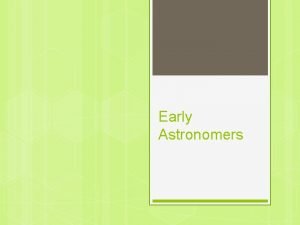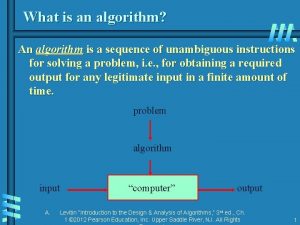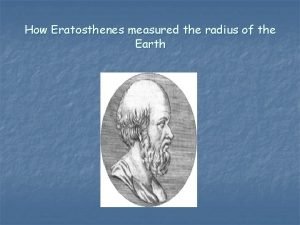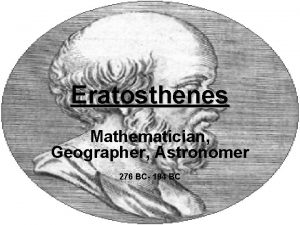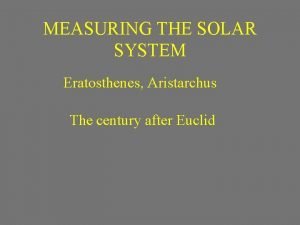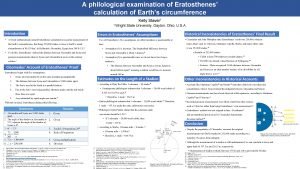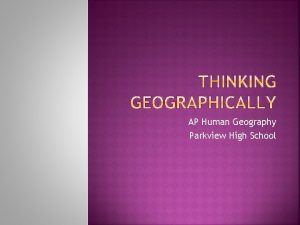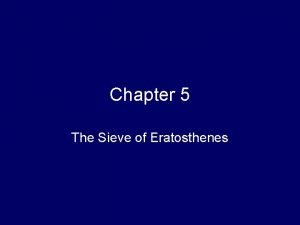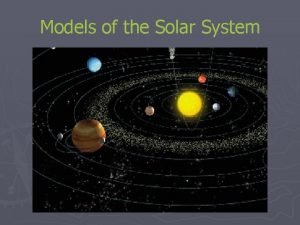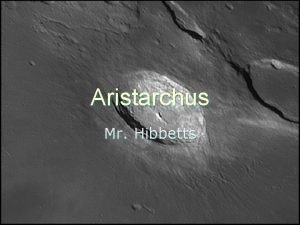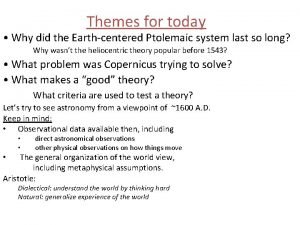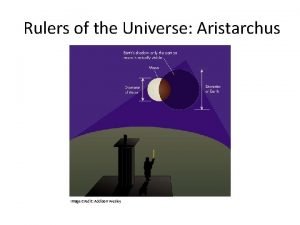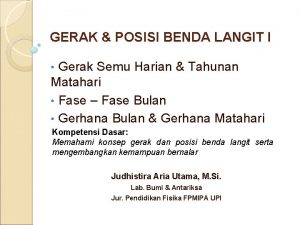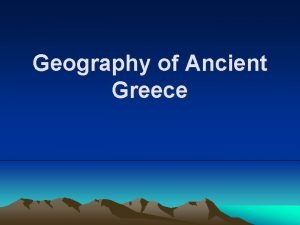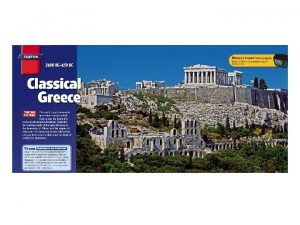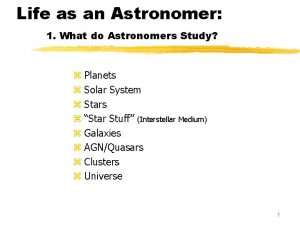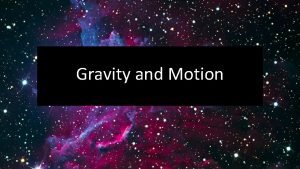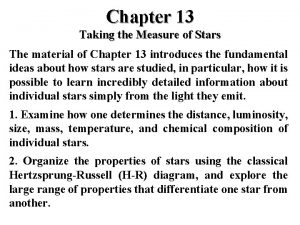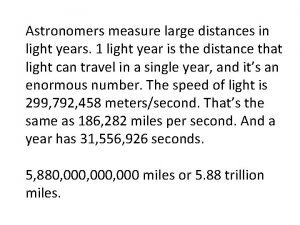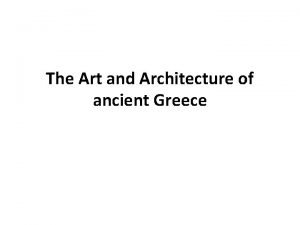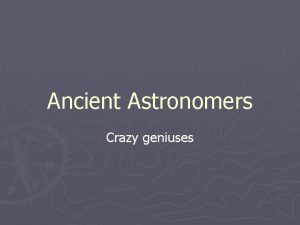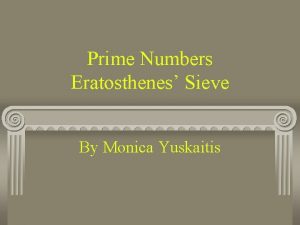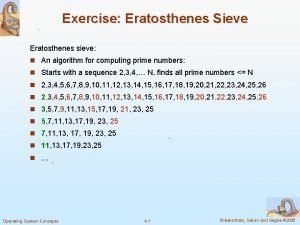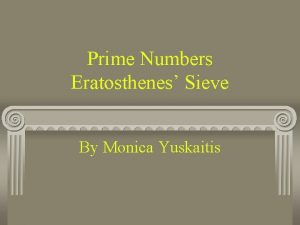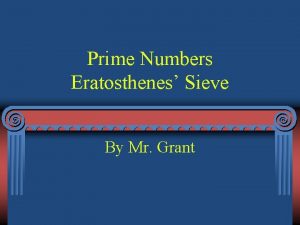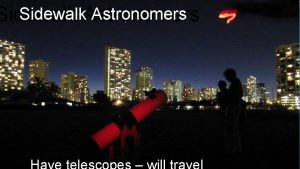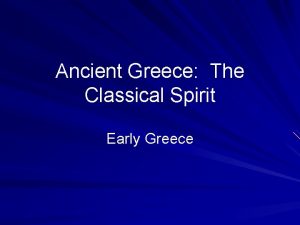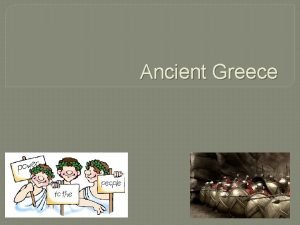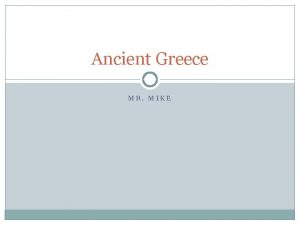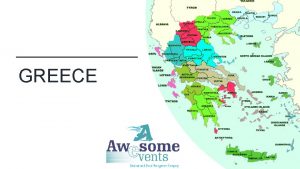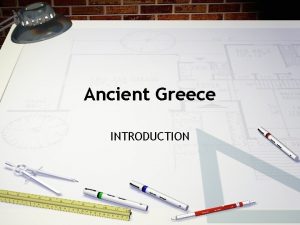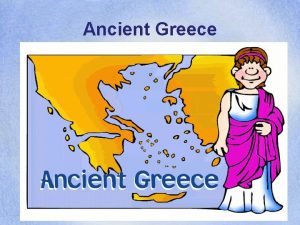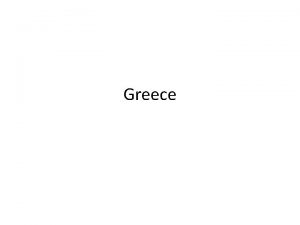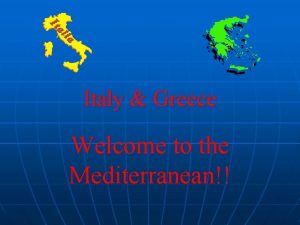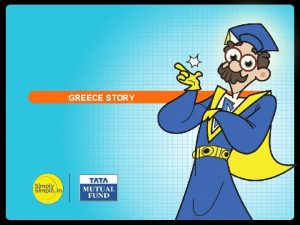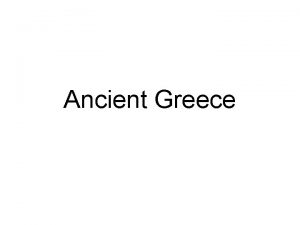Early Astronomers Aristarchus and Eratosthenes From Greece 4






















- Slides: 22

Early Astronomers

Aristarchus and Eratosthenes From Greece, 4 and 3 BC Based on observations believed in Heliocentric model Able to calculate the diameter of the earth, believing it was round. List observations they could have made to support their hypothesis Aristarchus Eratosthenes

Ptolemy Earth centric model, Believed the portions of the universe visible at the time were much smaller in scale and closer than Aristarchus who’s scale was a bit more realistic What observations would have lead to believing in an earth centered system? Ptolemy's model

Geocentric Modeling Please experiment with how a system would have worked based on the geocentric model. Use the sun, earth, mars, venus. Draw it in your lab journal first – then we will use the actual globes and lights to attempt to demonstrate. In your lab journal – write down three things that do not work with this model when you try to put it together physically.

Copernicus and Galileo Heliocentric model, with mathematical proof Used telescopes to view moons of Jupiter- which was evidence of _______? Our moon has craters and phases Venus went through phases similar to our moon Evidence which supports the ______ model.

Heliocentric modeling In your lab journal – sketch a heliocentric model – include Sun, Earth, Venus, Mars Consider Galileo’s observations, give three more reasons why this model works better to explain movements in our solar system What motion in the planets helps resolve other observation problems? Mars in retrograde, Venus phases, Retrograde motion

Tycho Brahe Known for his “naked eye” observations, both being accurate and huge in quantity Offered a “geo-heliocentric” model to accommodate a number of observations Used “stellar parallax” to calculate distance to stars he observed. Tycho Brahe

Geo-Helio Model by Tycho Brahe

Kepler used mathematics to prove and solve problems with other astronomers observations Kepler's laws are: 1. The orbit of every planet is an ellipse, with the Sun at one of the two foci. 2. A line joining a planet and the Sun sweeps out equal areas during equal intervals of time. 3. The square of the orbital period of a planet is proportional to the cube of the semi-major axis of its orbit.

(2) The two shaded sectors A 1 and A 2 have the same surface area and the time for planet 1 to cover segment A 1 is equal to the time to cover segment A 2. (3) The total orbit times for planet 1 and planet 2 have a ratio a 13/2 : a 23/2.

How do ellipses work? How is an ellipse different than a circle? How does this solve some problems of observation in the solar system? Mars in retrograde? Rate of speed of planets as they travel around the sun?

The flaws in previous thinking? Planetary orbits were perfect circles Size and speed of planets, orbits, etc Affects on each other en-route- hmm,

Moon Mapping We are going to track the moon for a month. This is a long term assignment, which will create a lot of data and questions. 1 st – put your name on the back of the paper and label according to my notes on the board. 2 nd – lightly, draw lines at the levels noted on the board. 3 rd – add a horizon line

Moon mapping requirements All moon’s must have date and time next to it, and be properly shaded based on your observation. Special notes will go on the back of the moon map as per class discussion Hypothesis ideas will also

Isaac Newton and gravity Contributions: laws of motion and gravity These laws could be applied to all things in the field of science – not just astronomy Worked with light and color, and built a reflecting telescope. Apple idea – why did the apple fall to the ground, why do the moons orbit larger planets, and why do planets orbit the sun? Gravity!

Universal Law of Gravitation "All bodies attract each other with a force proportional to the product of their masses, and inversely proportionate to the square of the distance between them. Okey – so what does that really mean? http: //ed. ted. com/lessons/jon-bergmann-how-tothink-about-gravity

Practically, this law says that large, heavy objects pull each other harder than small, light ones. And the pull is greater between objects near each other than objects that are far apart. Put that in context to the sun, the moon, the earth, and other planets. http: //www. richeast. org/htwm/NEWTON/Newton. htm

Question- If you drop a feather and a hammer which will land first? Why? Defend your answer with facts. http: //www. youtube. com/watch? v=4 m. Tsr. RZEM w. A

The formula - , And so, lets talk about those variables. What if?

What if? If you climbed to the top of Mt Everest would you feel less gravity? Why do you experience less gravity on the Moon? Which variable is at play in each of these problems?

Moon Map modeling Using your information from the moon mapping activity – please practice and show me what actions happen between the sun, moon and earth for the phases to appear as we observed them. On the back of your moon map draw the moon, sun and earth in the correct positions to show a full moon, and new moon. Show both your model and diagram to me to get checked off before proceeding.

Moon Map summary On the back of your moon map, after completing the modeling, and diagram, you need to write a summary that follows the format: The lunar period from full moon to full moon, both its orbital period, and rotational period. We only ever see one side of the moon, explain why that is the case. Refer to video Explain why we the moon rise/ set later and later each day. Include a statement about the lunar orbit and its rotation on its own axis. End your summary with two new things you learned from this observation period and modeling practice
 Aristarchus and eratosthenes
Aristarchus and eratosthenes Algorithm of sieve of eratosthenes
Algorithm of sieve of eratosthenes Eratosthenes biography
Eratosthenes biography 194 bc
194 bc Eratosthenes solar system
Eratosthenes solar system Eratosthenes assumptions
Eratosthenes assumptions Eratosthenes ap human geography
Eratosthenes ap human geography Number field sieve
Number field sieve Aristarchus model
Aristarchus model Aristarchus model
Aristarchus model Aristarchus accomplishments
Aristarchus accomplishments Aristarchus
Aristarchus Aristarchus
Aristarchus Akibat dari rotasi bumi
Akibat dari rotasi bumi Landforms of ancient greece
Landforms of ancient greece Early greece map
Early greece map Early cpr and early defibrillation can: *
Early cpr and early defibrillation can: * What do astronomers study
What do astronomers study Modern telescopes make it possible for astronomers
Modern telescopes make it possible for astronomers Astronomers measure the masses of stars by
Astronomers measure the masses of stars by Astronomers measure large distances in light years
Astronomers measure large distances in light years Ancient greek homes
Ancient greek homes Greek philosophers who contributed in physical education
Greek philosophers who contributed in physical education
